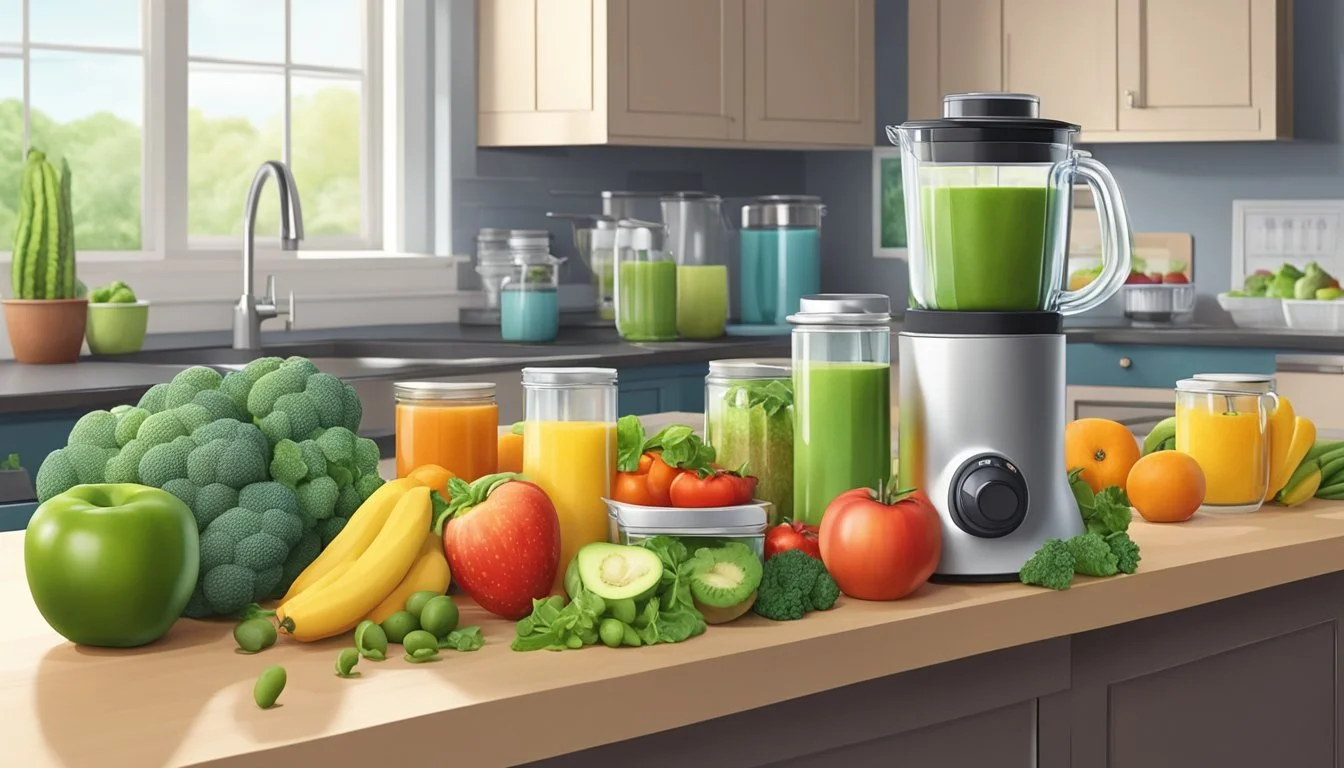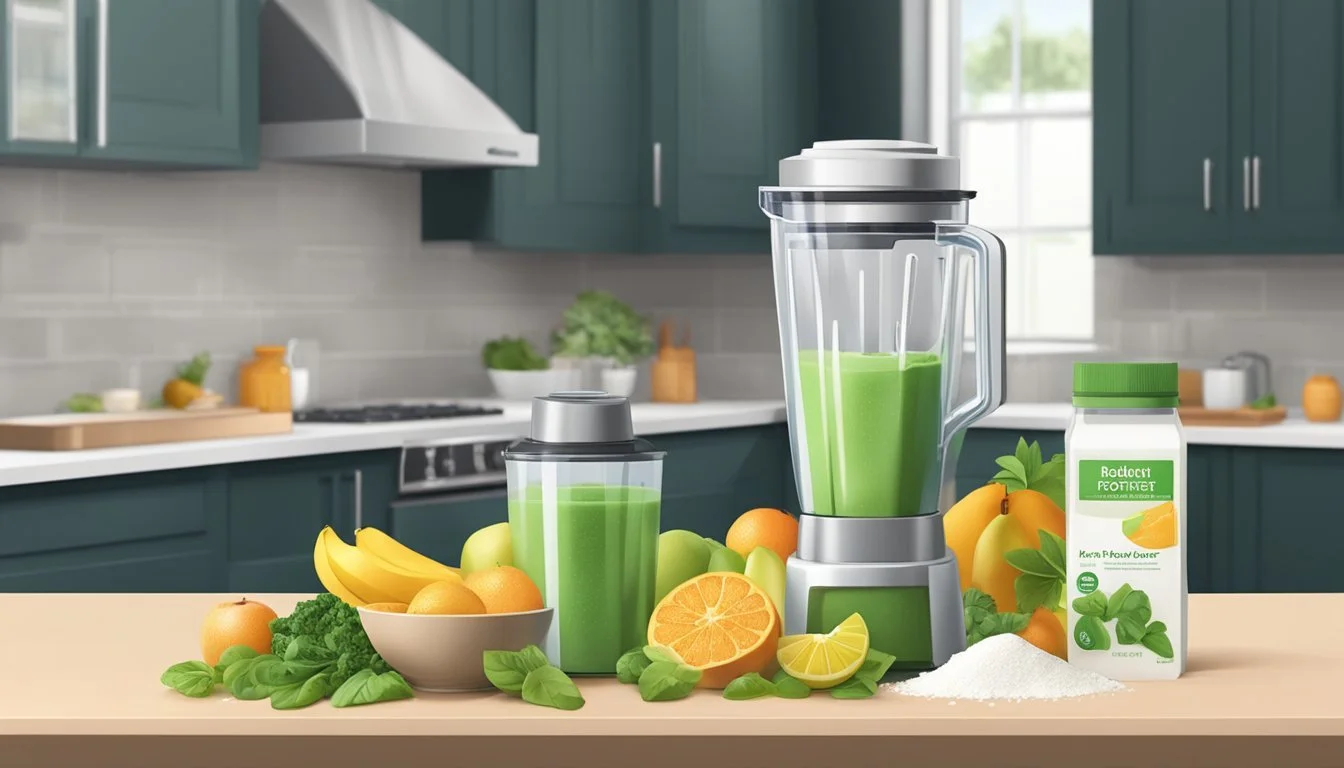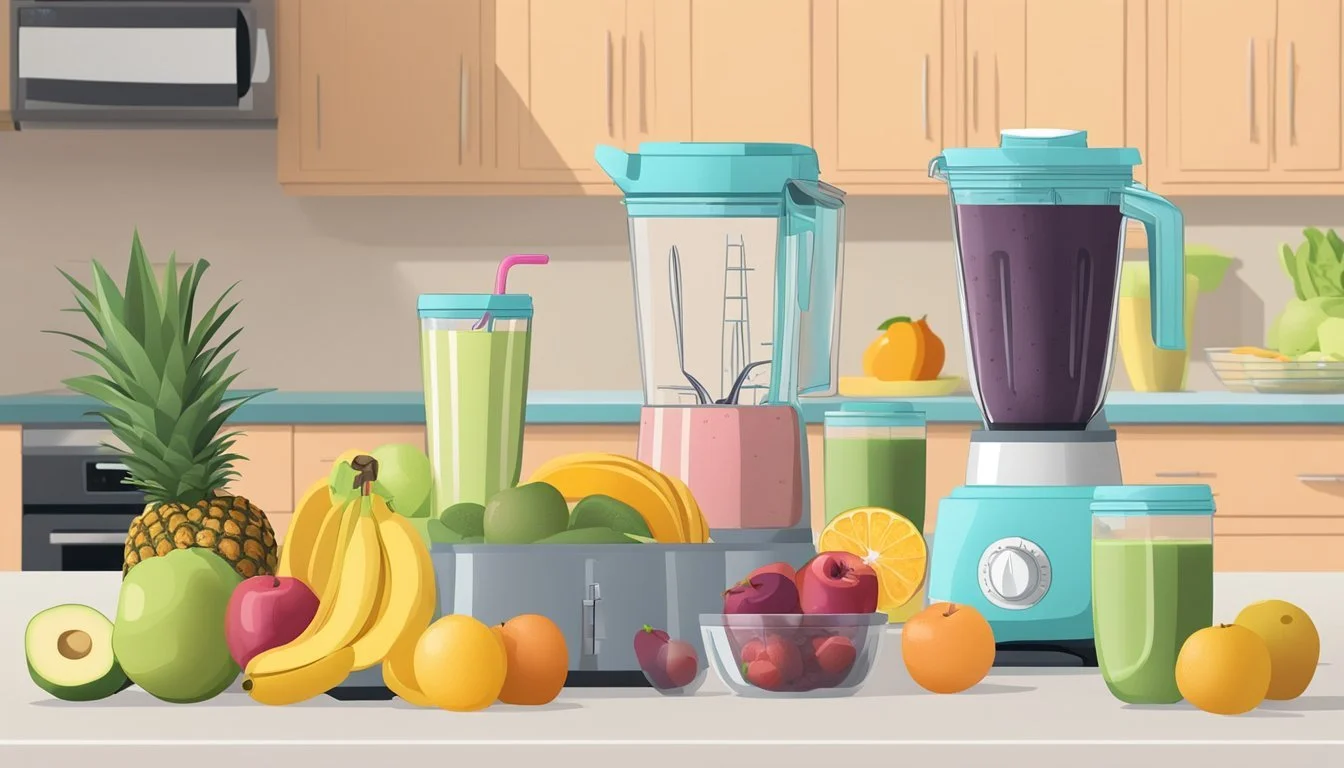How Long Do Freshly Prepared Smoothies Last?
Shelf Life and Storage Tips
Freshly prepared smoothies offer a nutritious and delicious way to consume a blend of fruits, vegetables, and other ingredients. They are particularly popular for their convenience and health benefits, providing an efficient way to consume a variety of nutrients in one serving. However, the shelf life of these beverages is crucial for those looking to prepare them in advance. The longevity of smoothies in the refrigerator typically ranges between 1-2 days.
Careful storage plays a significant role in preserving the freshness of a smoothie. An airtight container is key to maintaining the quality of the smoothie and preventing oxidation, which can lead to nutrient degradation and flavor loss. Smoothies that include dairy, or have a higher protein content, may have a shorter lifespan due to the perishable nature of these ingredients.
While they are best enjoyed shortly after preparation to maximize flavor and nutritional value, understanding the proper ways to store and preserve smoothies is important for those who need to prepare them ahead of time. To keep smoothies for the longest possible time within the 1-2 day window, ensuring that the container is not only airtight but also clean, and placing it in the coldest part of the refrigerator, can extend its freshness.
Factors Affecting Smoothie Shelf Life
The shelf life of freshly prepared smoothies is influenced by several factors, from the storage conditions to the ingredients used. Understanding these influences can help maintain the quality and nutritional value of the smoothie for as long as possible.
Temperature and Storage Conditions
Smoothies should be stored in the fridge at a low temperature, ideally between 35°F and 40°F, to slow the growth of bacteria and preserve freshness. Freezing them can extend the shelf life up to three months; however, it's important to use a BPA-free, airtight container to prevent freezer burn and oxidation. At room temperature, smoothies can deteriorate quickly, so immediate consumption is recommended.
Ingredients Used and Their Impact
The choice of ingredients significantly affects a smoothie’s shelf life. Smoothies with a higher acidity, such as those with lemon juice or lime juice, tend to last longer due to the preservative nature of vitamin C and other antioxidants. Ingredients like fruit, vegetables, and leafy greens provide essential nutrients but can ferment if not stored correctly. Smoothies with dairy products like milk or yogurt typically have a shorter shelf life, often only 1-2 days in the fridge.
Container Type and Its Role
Containers create a barrier to oxygen and contaminants. A glass mason jar or any glass container with an airtight seal can extend a smoothie's freshness by reducing oxidation. Plastic containers are viable, but they should be BPA-free to prevent chemical contamination. Always choose airtight containers to limit the smoothie's exposure to air, which hastens spoilage.
Preparation and Blending Techniques
Blending destroys the cell walls of ingredients, exposing nutrients to oxidation, which can degrade nutritional value over time. A vacuum blender can help reduce this effect by removing air from the container before blending. Blenders with high-powered motors, like Vitamix or Nutribullet, can create a more uniform concoction, which may help to evenly distribute preservative ingredients like citrus juice.
Presence of Preservatives
Natural preservatives such as citrus juice or vitamin C can help extend the shelf life of smoothies by providing antioxidant properties that slow oxidation. However, an overreliance on preservatives should be avoided to maintain the smoothie's nutrition. If additional shelf life is required, one may consider alternative preservation methods that won't compromise the nutritional integrity.
Proper Storage Practices
Keeping freshly prepared smoothies at their best requires specific storage methods to maintain flavor and nutritional value.
Refrigeration Guidelines
When storing smoothies in the refrigerator, using airtight containers is crucial to prevent oxidation, which can degrade the quality. Filling the container to the brim is advised as it reduces the presence of air that accelerates spoilage. Containers with an airtight lid safeguard the content from absorbing flavors from other foods in the refrigerator and further ensure freshness.
It is recommended to enjoy smoothies within 24 to 48 hours when kept in the refrigerator to preserve their taste and nutrient content. Utilizing materials such as glass mason jars or BPA-free plastic containers can be especially effective for refrigeration.
To enhance the storage life, place a piece of plastic wrap directly on the smoothie's surface before sealing it with the airtight lid; this additional barrier helps in preventing contact with air during storage. Remember that ingredients determine the lifespan of your smoothie; those with dairy or fresh greens may have a varied shelf-life.
Freezing and Defrosting Methods
When it comes to extending the shelf life of a smoothie, freezing is a reliable method. It allows one to enjoy a pre-made smoothie without compromising the quality or nutrients over a longer duration. Proper defrosting is essential to ensure the smoothie retains its original texture and flavor when ready to consume.
Using Freezer-Safe Containers
To effectively freeze a smoothie, one should utilize freezer-safe containers. These can come in various forms, including but not limited to freezer bags, mason jars, reusable silicone bags, and ice cube trays. Each option has its unique advantages:
Freezer Bags: They save space and can be laid flat, making stacking and storing multiple smoothie portions simple.
Mason Jars: Preferably use the ones with a wide mouth to allow for expansion as the smoothie freezes. Leave about an inch of headspace at the top to prevent cracking.
Reusable Silicone Bags: These are an eco-friendly choice and have a tight seal, ensuring the freshness is locked in.
Ice Cube Trays: For single-serve portions, one can freeze smoothies in ice cube trays and then transfer the cubes to a freezer bag for easy access.
The user should not fill containers to the brim, as the liquid will expand when it freezes. If using frozen fruit in the smoothies, this can help maintain a colder temperature, allowing the smoothie to freeze more uniformly.
Defrosting should be done with care to maintain quality. The safest method is to transfer the smoothie from the freezer to the refrigerator, letting it thaw for about 8 hours, depending on the size of the portion. However, for a quicker defrost, leaving a frozen smoothie at room temperature can take anywhere from 5 minutes to 3 hours. Observing the smoothie as it defrosts will prevent it from becoming overly liquid and losing texture.
Shelf Life Expectancy
When it comes to the shelf life of freshly prepared smoothies, their longevity largely pivots on storage conditions. The time frame for optimum freshness and safety varies from being refrigerated to frozen, with each method offering a different lifespan.
Typical Lifespan in Different Conditions
In the Fridge: A freshly prepared smoothie can last between 24 to 48 hours when stored in the refrigerator. It is critical to store the smoothie in a clean, airtight container to maintain its taste and prevent spoilage. The presence of dairy products may limit the freshness to approximately 24 hours.
In the Freezer: For long-term storage, a smoothie can be kept in the freezer for up to 3 months. The key to freezing is also using a clean, airtight container. To consume, one must thaw the smoothie in the refrigerator, ideally overnight.
One should note that while these are typical time frames, a smoothie's freshest state is immediately after preparation, and the longer it is stored, the more the quality will diminish.
Assessing Smoothie Quality
Freshly prepared smoothies can undergo changes that may impact their quality. Consumers should be aware of how to assess these changes to ensure the smoothie is still enjoyable and safe to consume.
Visual and Texture Changes
Visual Changes: A smoothie is best consumed when it presents a vibrant color, indicating the freshness of its ingredients. Over time, oxidation can cause the color to turn brown, particularly in smoothies containing bananas or apples, as these fruits oxidize quickly. This browning does not necessarily mean the smoothie is spoiled, but it may indicate a loss in nutritional value and a change in taste.
Texture Changes: A fresh smoothie has a characteristically smooth and even consistency. As the smoothie sits, separation can occur, and the texture may become grainy or inconsistent. Ingredients such as seeds or fibrous vegetables might settle at the bottom, altering the texture when consumed. Such changes in texture can also affect the overall taste and smell of the product, which in turn, can be an indicator of its freshness.
Maximizing Smoothie Benefits
To harness the full potential of smoothies, selecting the right ingredients is crucial. The following section provides insights into how fresh, nutrient-dense components not only enhance flavor but also ensure that each sip is packed with vitamins and nutritional value.
Using Fresh and Nutritious Ingredients
When crafting a healthy smoothie, the importance of using fresh ingredients cannot be overstated. Fresh fruits and vegetables retain more nutrients and vitamins, delivering a greater health boost with every serving. Here are specific ways to maximize the benefits:
Greens: Incorporate a variety of greens such as spinach or kale to elevate the nutrient profile. A spinach smoothie or a green smoothie typically contains high levels of iron, calcium, and vitamins A, C, and K.
Fruits: Adding fruits like banana, berries, and avocado not only provides natural sweetness and creaminess but also supplements the smoothie with essential vitamins, antioxidants, and heart-healthy fats.
Berries: A berry smoothie can offer a concentrated dose of antioxidants and fiber, promoting overall health and aiding in disease prevention.
Balance: To create a nutritious blend, aim for a balance between fruits and vegetables. This ensures a complex nutrient profile, including a vast array of vitamins, minerals, and antioxidants.
By prioritizing freshness and nutritional content, one can craft healthy smoothies that are not only delicious but also functional, serving as a potent source of daily nutrition.
Tips for Longer Lasting Smoothies
To extend the freshness and nutritional value of smoothies, individuals can employ certain preservation methods that tackle oxidation. These tips can help smoothies maintain their appeal both visually and in terms of taste.
Adding Natural Antioxidants
Incorporating natural antioxidants into smoothies can significantly curtail the oxidizing process. Antioxidants bind with free radicals that cause oxidation, hence preserving the smoothie's integrity. Vitamins C and E are effective antioxidants that one can include. A squeeze of lemon or lime juice not only adds a zest of flavor but also provides vitamin C, which helps in slowing down the degradation process. Similarly, chia seeds are not only high in antioxidants but also add a nutritional boost. Moreover, incorporating chlorophyll-rich greens like spinach or kale can contribute to the smoothie's longevity due to their antioxidant properties.
Sealing Techniques to Reduce Oxidation
A crucial step in smoothie storage is to minimize its exposure to oxygen, which accelerates spoilage. Utilizing airtight containers is essential in preventing oxygen from oxidizing the contents. Here's a list of sealing methods:
Mason jars: Their tight seal is effective at keeping air out.
Vacuum-sealed bags: While not common for liquids, they are excellent at removing air.
Layering: Pouring a thin layer of oil or water over the top of the smoothie can create a barrier from oxygen.
When individuals plan to consume their smoothies later, proper sealing is equally as important as the ingredients used. For those involved in meal prep, preparing smoothies in advance and sealing them correctly ensures a convenient and healthy meal option throughout the week.
Health Considerations and Nutritional Information
When it comes to freshly prepared smoothies, preserving their nutritional integrity and understanding the impact of storage on nutrient levels is crucial for those seeking the health benefits associated with these beverages.
Impact of Storage on Nutrients
The nutrient composition of a smoothie is affected by the length of time it is stored. Vitamins, particularly vitamin C and some B vitamins, are sensitive to air, light, and temperature, and their levels may diminish over time in a stored smoothie.
Protein: If a smoothie contains protein-rich ingredients such as yogurt or protein powder, the protein content typically remains stable during refrigeration, although the smoothie's texture can change.
Weight Loss: For individuals using smoothies as a weight loss aid, it is important to consume them when they are most nutrient-dense, which is usually immediately after preparation.
Benefits: Freshly made smoothies are replete with the benefits of their ingredients, like fiber from vegetables or leafy greens, which is essential for digestive health.
Vegetable and Greens: These ingredients bring a wealth of vitamins and minerals to a smoothie, but with storage, light, and heat exposure, some of the nutritional value may decline. Leafy greens in particular are high in chlorophyll and can help prolong the freshness of a smoothie, but even these can degrade over time.
For those looking to gain the maximum nutritious benefits from smoothies, it's recommended to consume them shortly after preparation to ensure the highest nutritional value.
Special Recipes for Extended Storage
In third-party testing, certain recipes stand out for their ability to remain fresh when frozen, offering extended storage options for both homemade and store-bought smoothies.
Smoothie Recipes for Freezing
Freezing smoothies is a practical method to preserve their delicious taste and nutritional benefits. Preparing smoothies specifically for freezing involves selecting ingredients that freeze well and employing appropriate techniques to maintain quality.
Citrus Packed Smoothie: Smoothies with a high content of citrus juice, like orange or lemon juice, tend to last longer due to the preserving nature of the citrus acid.
Berries and Yogurt Delight: Berries freeze exceptionally well, and smoothies made with yogurt can provide a creamy texture that withstands freezing and thawing.
Steps for Freezing:
Choose the Right Container: Glass jars with airtight lids are ideal. If using glass, one should make sure it is of the tempered type to avoid cracking.
Leave Space: Liquids expand when frozen, so it is crucial to leave an inch of headspace in the container to accommodate this expansion without breaking the container.
Remove Air: Oxidation affects taste and nutritional value, hence, it is advised to remove as much air as possible before sealing the container.
Form Ideas:
Standard Freeze: Pour the smoothie into containers, leaving appropriate headspace, seal tightly, and place them in the freezer.
Ice Cube Trays: Pouring smoothies into ice cube trays, then transferring the frozen cubes into bags, allows for easy portion control.
Popsicle Molds: For a fun twist, smoothie ingredients can be frozen in popsicle molds for a frozen treat that is both convenient and enjoyable.
To ensure quality, smoothies should be consumed within 1-2 months of freezing for the best taste and nutrient preservation. Thawing usually takes about 8 hours in the fridge or a faster method can be employed by leaving them at room temperature for a shortened period.
Conclusion
When safeguarding the longevity of smoothies, whether homemade or store-bought, proper storage is paramount. Fresh smoothie enthusiasts should aim to consume their blends within 24-48 hours when kept in the refrigerator. Utilizing an airtight container is essential to prevent oxidation, which can deteriorate the taste and nutritional value.
In the context of a leftover smoothie, one must be vigilant for signs of mold growth, especially if dairy or protein-rich ingredients are used as they render the beverage more perishable. For an extended shelf life, smoothies can be frozen, maintaining quality for up to three months. Defrosting should be done in the refrigerator to ensure safety and preserve flavor.
Refrigeration:
Consume within: 1-2 days
Container: Airtight, clean
Freezing:
Consume within: 3 months
Defrost: Overnight in fridge
Careful consideration of ingredients can enhance preservation. For instance, citric acid in lemon juice acts as a natural preservative. Conversely, an overabundance of sugar from excess fruit should be avoided, as it could potentially lead to quicker spoilage.
In summary, the key factors influencing the shelf life of smoothies are the quality of ingredients, container cleanliness, and storage conditions. Adhering to these practices allows one to relish their nutritious beverage safely and enjoyably.









